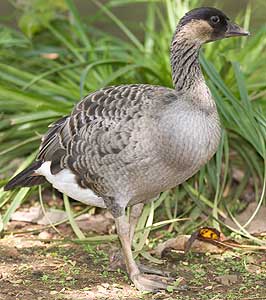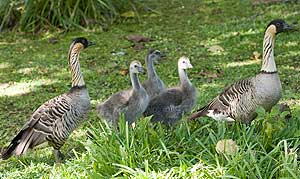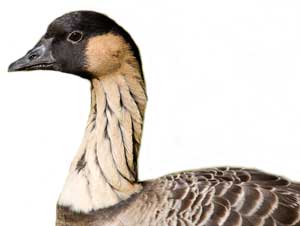This regal goose is Hawai`i's state bird. The Nene measures between 22 to 26 inches in length, has a black head and bill, yellow-buff cheeks, a buff neck with dark furrows, and partially webbed black feet. The reduction of webbing between their toes enables them to walk more easily on the rugged lava flows. Its loud calls are like those of the Canada Goose and when disturbed, its call resembles the "moo" of a cow.
Habitat & Behavior:
 Nene frequents scrubland, grassland, golf courses, sparsely vegetated slopes and on Kaua`i, in open lowland country. The Nene's vegetarian diet consists of seeds of grasses and herbs as well as leaves, buds, flowers and fruits of various plants. The Nene does not appear to need fresh water but will use it when available. Although Nene are found mostly in the rugged lava fields of the Big Island, this is probably the only place they have survived rather than their preferred habitat.
Nene frequents scrubland, grassland, golf courses, sparsely vegetated slopes and on Kaua`i, in open lowland country. The Nene's vegetarian diet consists of seeds of grasses and herbs as well as leaves, buds, flowers and fruits of various plants. The Nene does not appear to need fresh water but will use it when available. Although Nene are found mostly in the rugged lava fields of the Big Island, this is probably the only place they have survived rather than their preferred habitat.
The breeding season is from November to June. Their nests are down-lined and usually well concealed under bushes. The Nene seem to prefer nesting in the same nest area, often a "kipuka" (an island of vegetation surrounded by lava). Two to five white eggs are usually laid and the incubation period is 30 days. Nene goslings are flightless for about 11 to 14 weeks after hatching. Family groups begin flocking soon after the young are able to fly and remain in the breeding grounds for about a month. They wander about searching for food after that.
Past & Present:
 Fossil records show that the Hawaiian Goose used to live on all the main Hawaiian islands. It is believed that they were abundant (about 25,000 birds) on the Big Island before the arrival of Captain James Cook in 1778. Today, the Big Island is the only place where they are found naturally in the wild. Scientists believe that the Maui population became extinct before 1890. The decline in numbers was accelerated during the period of 1850 to 1900 due to aggressive hunting of the birds and collecting of their eggs. In 1951, the Nene population was estimated at only 30 birds.
Fossil records show that the Hawaiian Goose used to live on all the main Hawaiian islands. It is believed that they were abundant (about 25,000 birds) on the Big Island before the arrival of Captain James Cook in 1778. Today, the Big Island is the only place where they are found naturally in the wild. Scientists believe that the Maui population became extinct before 1890. The decline in numbers was accelerated during the period of 1850 to 1900 due to aggressive hunting of the birds and collecting of their eggs. In 1951, the Nene population was estimated at only 30 birds.
Their continued decline was attributed to the introduction of alien plants and animals. The Nene is extremely vulnerable to predation by introduced animals like rats, dogs, cats, mongooses, and pigs. In more recent studies, research shows that continuing decline of the Nene population in the wild can be attributed to low productivity, perhaps caused by the poor available nutrition in their habitat. Approximately 500 Nene exist in the wild today.
Conservation Efforts:
Many public and private organizations have been actively operating and supporting propagation programs to reestablish the Nene in the wild. The State of Hawai`i reintroduced them to Kilauea Point and Hakalau Forest National Wildlife Refuges. The National Park Service has rearing programs at Hawai`i Volcanoes National Park and Haleakala National Park. The Wildfowl Trust in England has also played a major role in the survival of the Hawaiian Goose; they propagate and distribute the Nene to many zoos, aviaries, and the wild.Today Nene are being raised in captivity at the Maui Bird Conservation Center at Olinda and the Keauhou Bird Conservation Center on the Big Island, both operated by the Peregrine Fund. Young birds are then released into protected habitats by the State.
The Hawaiian Goose was listed as an endangered species in 1967 under the Federal Endangered Species Act. The Hawaiian Goose Recovery Plan was published in 1983. It outlines the essential elements to accomplish a goal of establishing 2,000 geese on Hawai`i and 250 on Maui. These elements are to minimize the mortality rate in the wild, continue release of captive-bred birds, and to protect and improve habitat where the Nene can maintain their populations naturally.
